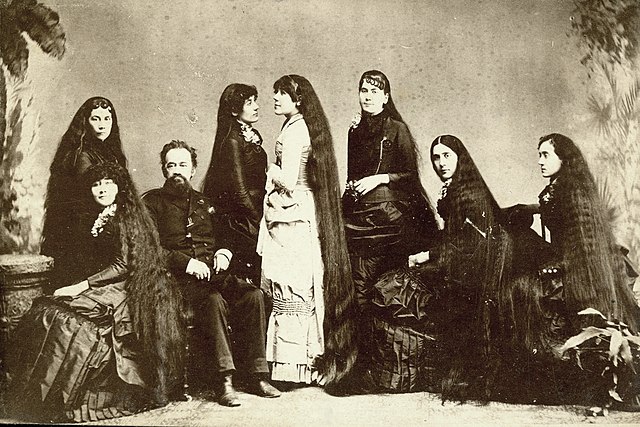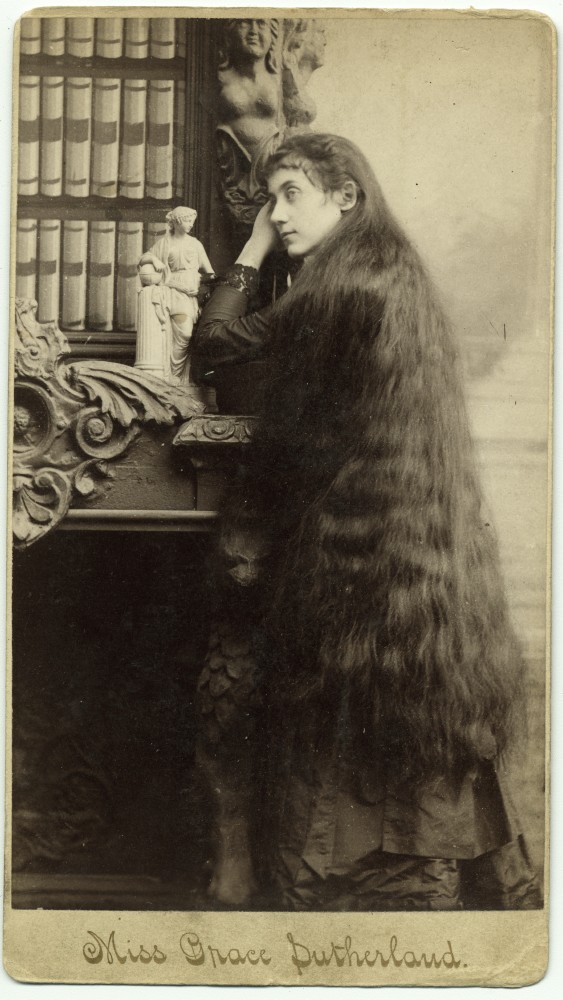THE STRANGE SAGA OF THE SUTHERLAND SISTERS


There’s no delicate way to say this, so here goes. Your great-great-grandparents had a weird thing about hair.
The Victorians were obsessed with lovely locks. People have always admired a nice head of hair. But Victorians were bonkers for beautiful tresses.
They snipped strands of dead loved ones’ hair for keepsakes. They put their locks inside lockets and photo cases for paramours. And they made hair jewelry. Seriously, it was a thing. They wove it into bracelets, brooches, watch fobs, and more.
Decades before the musical “Hair” took Broadway by storm, a musical group swept the country at the height of hair’s heyday and, in turn, peddled a concoction that made a fortune. This is the story of seven sisters and their combined 37 feet of hair.
Life wasn’t easy on the Sutherland family’s turkey farm in Niagara County, N.Y. Fletcher Sutherland was like Pa Kettle, a lazy ne’er-do-well content to let everyone else do his work for him. Daughters Sarah, Victoria, Isabella, Grace, Naomi, Dora, and Mary herded the birds barefoot and in dingy dresses. Smooth-talking Papa Sutherland preferred preaching and politicking and basically anything (apart from manual labor) that let him flap his jaw.
His daughters were so ashamed of their appearance they hid when company called, especially after their longsuffering mother died in 1867.
But one thing set the Sutherland sisters apart. Their remarkably long, lovely hair which they grew to their waist and beyond. People raved about it.
Their mother had drenched their heads with a foul-smelling mixture she cooked up to make their hair luxuriously beautiful. It smelled so bad kids wouldn’t sit beside them in school. When the mom passed away, the odious ointment went to the grave with her.
The girls (along with brother Charles) began playing musical instruments and singing. Their daddy, always looking for a chance to make a quick buck, booked them at churches.
Soon, the act became the talk of Upstate New York. Musically, it was nothing special. The kids weren’t bad; they weren’t great, either. But people weren’t coming to hear their songs. Folks flocked to see their incredible hair.
Fletcher Sutherland knew a good thing when he saw it. He billed the sisters as “The Seven Wonders.” (Brother Charlie was given the boot; there was no interest in an adolescent boy with average hair). By December 1880 they reached Broadway where audiences gazed admiringly at the girls’ combined total of 37 feet of hair.
The act began with the sisters sporting braids atop their heads. The highlight came when they turned their backs and unpinned it, unleashing a tidal wave of hair. Caught in glowing gaslight, crowds gasped in amazement at the wondrous sight. Victoria fascinated showgoers the most with her seven feet of hair. Mary was the slacker with a mere three feet.
In 1884 they hit the big time: A sideshow with Barnum and Bailey’s Circus, “The greatest show on Earth.” P.T. Barnum promoted them as, “The seven most pleasing wonders of the world.”
The sisters were different from their colleagues. They weren’t viewed as “circus people” shunned by polite society. They conducted themselves as dignified proper ladies. Though his girls were now bona fide celebrities, it still wasn’t enough to satisfy their father’s voracious greed.
So Fletcher Sutherland partnered with promoter Harry Bailey, distant cousin of the Bailey in Barnum and Bailey. They resurrected Ma Bailey’s hair ointment, changing the formula so it wasn’t so disgusting smelling. Soon “The Seven Sutherland Sisters Hair Grower” was being sold.
They got a chemist to write, “I hereby certify that I found it free from all injurious substances … and I cheerfully endorse it.” In the days before the FDA, that was good enough for gullible consumers. By 1884 the company had raked in $90,00 in sales (about $2.7 million today).
Sutherland was a wealthy man when he died in 1885. The sisters gradually got involved in the company and proved themselves shrewd businesswomen. They expanded the product line to include brushes and other hair-related products, all marketed to upper-class women who could afford their extravagant prices. By 1890, their Hair Grower (also sold as “Hair Fertilizer”) had sales of $3 million (around $97.6 million in 2022).
The sisters married, started families, and became eccentrics. They lived together in a gaudy 14-room mansion built on the family farm. Despite their facade of Victorian respectability, behind closed doors, they would have been “The Real Housewives of Cambria, New York.” There was alcoholism, complicated extramarital affairs, and even whispers about witchcraft—enough fodder for a tabloid.
Naomi died suddenly in 1893 before turning 40, dramatically shaking the surviving sisters. They toured on and off with Barnum until 1907. But the 20th century’s arrival saw Americans’ fascination with hair rapidly fading. Sales of their products plunged as extravagant living caught up with them.
Desperate for cash, the last three sisters went to Hollywood in 1919 on a trip so disastrous that not only did a movie deal fall through but Dora was killed in a car crash. Things only got worse from there.
 The mansion was sold in 1931 (burning in 1938); the hair business went belly-up in 1936; Mary died in an insane asylum in 1939; and when Grace, the final sister, passed away in 1946 at age 92 she was dirt poor.
The mansion was sold in 1931 (burning in 1938); the hair business went belly-up in 1936; Mary died in an insane asylum in 1939; and when Grace, the final sister, passed away in 1946 at age 92 she was dirt poor.
In the end, the Sutherland Sisters wound up right back where they had started.
Did you find this enjoyable? Please continue to join me each week, and I invite you to read Tell it Like Tupper and share your review!
Curious about Tell It Like Tupper? See for yourself. Take a sneak peek at a couple of chapters in this free downloadable excerpt.
